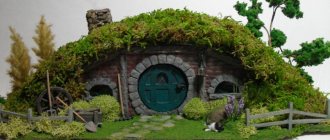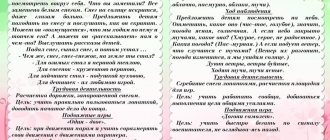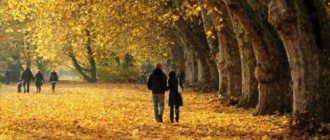Autumn signs of autumn in living and inanimate nature: list
For many schoolchildren, autumn is associated with the beginning of a new school year; at this time, children meet with their friends and classmates, and, dressed in school uniforms, go to gain new knowledge.
There are the following signs of the onset of autumn:
- Surely the kids noticed when autumn came, the sun had disappeared somewhere, and the sky was covered with clouds. Even in sunny weather, it is no longer so warm outside (you can tell by the way people start dressing). Light T-shirts and dresses are replaced by jackets and jeans, and with the onset of October-December, many people wear coats and jackets.
- Despite the fact that summer is hot, there are, of course, windy weather. But it’s more pleasing, because when a warm breeze blows, it’s refreshing. But strong gusts of wind in autumn are not so pleasant, because the cold wind blows with such force that it tears leaves from the trees.
- Autumn is characterized by frequent fogs, and mothers begin to monitor weather changes, because in autumn the weather often changes, and dressing correctly is very important at such a time, because... it's very easy to get sick. By the way, with climate change, many children begin to get colds, which is rarely seen in the summer.
- The coming autumn can be seen in the plants, for example, how grapes or currants turn red, chestnuts and many other trees and shrubs turn yellow. In September it is already possible to collect fallen maple leaves. They are often used to make appliques or various bouquets. But it is impossible to determine the onset of autumn by looking at coniferous trees, because such trees are green both in summer and winter.
Autumn motives
- You can determine weather changes by watching animals. For example, most birds hide from the cold by flying to warmer regions. Of course, there are those who are not afraid of the cold - these are pigeons, crows and sparrows. But heat-loving birds, sensing the onset of rainy autumn, immediately fly far to the south with their chicks.
- There are animals that hibernate, such as bears, raccoons, badgers, hedgehogs and many others, especially those that live in minks. The hare, fox and squirrels change their color, making it easier for them to camouflage themselves from predators. As you know, squirrels are very thrifty - so they prepare a lot of nuts and acorns for the winter, which they will feed on throughout the cold weather. And they collect food in the fall, when nuts and acorns are ripe. This can also be observed.
- Pesky flies, mosquitoes and many insects also hide with the onset of the slightest cold weather.
- Why has the day become shorter? This also characterizes autumn. If the sun sets earlier than usual, then you can expect the onset of cold days. This is a sign of autumn in inanimate nature.
- Getting closer to winter, you can see frost in the mornings. These are small particles of dew that have frozen on the leaves and surfaces in an uneven, prickly layer.
- There is even ice in the fall; this often happens at the end of November, when the air temperature reaches sub-zero values. By this time people are already wearing hats, gloves and scarves. The weather promises that winter is just around the corner.
Autumn is a very bright and beautiful time of year, the roads are covered with a golden “blanket”, you can watch beautiful landscapes and birds flying away to warmer climes. Even though the weather is rainy in autumn, it gives us the opportunity to observe the beauty of nature.
Objects and phenomena of living and inanimate nature in autumn: description of observations
On the territory of our country one can often observe changes in the weather and nature, which “adjusts” to the coming changes. Many of the phenomena that we observe are associated specifically with the seasons and are therefore called seasonal. One of the most beautiful times of the year is autumn.
During this period, nature is painted with golden colors, all animals and plants are preparing for the cold winter and you can observe the most amazing changes and phenomena. Autumn is characterized by the following main changes:
- Fogs. This phenomenon can be explained by the fact that the earth heats up during the day, and at night the temperature is already below zero, so fog, dew and even frost are observed with sunrise
- Shower. Autumn is associated with rainy weather, and it is during this period that heavy rains are observed - in other words, downpour
- Wind. It is in the fall that when you go outside you can encounter strong gusts of wind, which are often accompanied by rain or even hail.
- It gets dark earlier
- Cloudy weather
- You can see thin ice on ponds and puddles, but standing on it, much less playing on it, is very dangerous; it’s better to wait until winter
- The onset of winter can also be characterized by “Indian” summer. During this period, a heavy milky fog falls to the ground, filling the air with dampness.
- At the end of autumn, rainy weather is diluted by light snowfall, after which there is often ice
Golden autumn
This is a characteristic of inanimate nature that can be observed in the fall, but changes in living nature include:
- Animals such as fox, squirrel and hare change their color
- Many animals hibernate in late autumn
- Birds fly to warmer climes
- Insects also hide from the cold weather, you can no longer see butterflies and ladybugs, you can’t hear the whistle of grasshoppers, bees don’t buzz and don’t pollinate plants, mosquitoes and flies are also becoming less and less common
- Leaf fall. This is the first sign that golden autumn is coming. The castings turn yellow, and with a strong gust of wind, trees and bushes are freed from them. All roads are covered with a beautiful golden carpet
Autumn is a wonderful time of year that prepares nature and people for the cold frosty winter. This time gives us a break from the hot and stuffy summer days. But the first ones who begin to respond to climate changes are plants. Berries and vegetables are fully ripening, and the trees are dressed in golden foliage.
Winter signs of winter in living and inanimate nature: list
In anticipation of the New Year, many children know that the luxurious time of year has arrived - winter. Gifts, holidays and Father Frost and the Snow Maiden are not all indicators that winter has come. Of course, it comes a month earlier - December 1st. This is a fabulous time when you can play in the snow and sculpt a Snow Woman, we see stunning drawings on the windows, and there is beautiful snowy weather outside.
In anticipation of the onset of winter, we are all waiting for a fairy tale, wish fulfillment and magic. This is how we associate cold winter. But these are not all the indicators by which one can determine the onset of such a wonderful period:
- Firstly, everyone dresses warmly enough. A down jacket or fur coat is used as outerwear; people wear warm gloves and hats, and in very “severe” weather - huge scarves and thermal underwear. It is very important to dress as warmly as possible in such cold weather, because you can easily catch a cold and miss the entire winter holidays
- Snowfall is also the main characteristic of the winter period.
- The winter sky is quite heavy and seems to hang right above your head. There is moisture and frosty freshness in the air
- Ice. Walking or driving in winter is very dangerous; for convenience, many people wear snowshoes, and their cars are “changed” to winter tires. After all, it’s very easy to slip, and worse, to injure your leg or arm.
winter snowstorm
- If a strong wind blows and snow falls, it becomes a blizzard. It’s very exciting to watch such weather from the window, but if you get caught in a strong wind with snow, it’s quite unpleasant
- As children, we all really loved icicles. And this is another sign of winter. In other words, an icicle is a cone-shaped piece of ice that can most often be found on roofs or trees.
- Animals, birds and insects, unfortunately, can be found very rarely, because birds fly away to warmer climes, animals hibernate, and insects hide from the severe frosts that are typical for winter
- Days are much shorter than nights
Despite the cold temperatures and snowstorms, winter is a wonderful time; many games can only be played thanks to the snow that only falls in winter. Skiing, sledding, snowboarding, playing snowballs or sculpting various figures out of snow - these are very exciting and educational activities that are possible only in winter. Therefore, the winter holidays should not be spent sitting in front of a computer monitor, but rather have a great free time with friends or family.
Natural phenomena in winter
At this time of year there are such interesting and unusual natural phenomena as:
- Blizzard
- Black ice
- Icicles
- Frost patterns
A blizzard appears with the first gusts of wind and, boldly picking up the snow cover, carries it away into a mysterious winter dance. This is a very harsh natural phenomenon that it is better not to encounter on the way. The blizzard boldly controls the snowy landscape and arranges fluffy snowdrifts at will. Most often this happens in the middle of winter, when frost and cold reign supreme.
Black ice, like a sweet winter dream, binds water bodies and covers not only the continuous flow of rivers, but also all roads with a thin crust of ice. This happens if, after rain or sleet, the temperature drops below zero. Ice on the rivers prevents navigation, but provides ample scope for all kinds of winter activities, such as sledding, skating or skiing.
Another interesting winter phenomenon is icicles. They, like ice daggers, fall into the ground and crumble into hundreds of sparkling fragments. Icicles form when snow on roofs or other flat objects begins to melt, and the resulting water freezes at low temperatures at night.
Frosty patterns, like frost, are an incredible lace creation of winter. Their whimsical design and mesmerizing beauty leave a lot of room for imagination and immerse you in a snowy fairy tale. This becomes possible due to the formation of ice crystals settling on the irregularities of the glass. They overlap each other and create pictures of incredible beauty.
Winter is not only a beautiful time of year, but also a very unusual one. She is like a big mystery that has yet to be solved. For example:
- snow is a real work of art and there are no two identical snowflakes in the world.
- Snowflakes are 95% air, which is why they fall to the ground so slowly.
- In Antarctica you can find purple, pink or red snow.
- In different countries and parts of the world, ice has different temperatures. For example, the coldest ice is found in Antarctic glaciers and reaches -60 degrees Celsius, and the warmest (0 degrees) is on the tops of the Scandinavian mountains and the Alps.
- More than half of the world's inhabitants have never seen real snow.
- On February 18, 1979, snowfall was recorded in the Sahara Desert, which is one of the hottest places on the planet.
- You can enjoy the warmest winter in Northern Sudan. There at this time of year the temperature rarely drops below +40 degrees.
- One of the coldest and most uninhabitable places is Antarctica. In winter, the air temperature there averages -70 degrees. And at Vostok station, which is located in Antarctica, a temperature of -89.2 degrees was recorded.
Winter is a wonderful and fabulous time of year, when, despite the short days and frosty air, life does not freeze, but is filled with new light and sound. The snow-white blanket of snow and snowflakes sparkling in the sun, the unique patterns on the glass and the ice crust that binds rivers and lakes are endlessly pleasing to the eye. The prickly frost, lovingly touching your cheeks, reminds you of how many outdoor games this time of year conceals and makes you freeze in anticipation of the New Year holidays.
Winter is a fierce time, especially in the north of the planet. Sometimes its appearance does not coincide with calendar time. Signs of winter may appear earlier. The slushy weather changes to frost, ponds freeze, and the ground is covered with a white blanket of snow. During this period the days are short and the nights are cold.
Objects and phenomena of living and inanimate nature in winter: description of observations
Nature is everything that surrounds us and is created by human hands. Conditionally, nature can be divided into living and nonliving. The first group includes plants, animals, fungi, humans, and microbes. But to inanimate nature: the sun, air, stars, soil, precipitation, etc.
In winter, summer, autumn and spring, all phenomena change smoothly, and this is how we can determine the seasons of the year. Winter is the coldest time of the year, but this is also the most beautiful time. In winter, the season of fun snowball fights opens, children ride on slides and sleds, make a snow woman, and most importantly, everyone is looking forward to a fabulous New Year. This time can be determined by the following signs:
- Snow is more often observed in the form of precipitation. Snowflakes fall to the ground either independently or in flakes. And also only in winter you can see snowfall - this is heavy snowfall
- Blizzard and blizzard
- Ice. Of course, all kids love to skate, but this activity is quite dangerous, so you can only play on the ice if accompanied by adults
- Icicles can be found on the roofs of houses and tree branches. Therefore, you need to be careful, and it is better not to walk under houses, because if the temperature gets higher, the icicle can easily melt and fall
- Santa Claus decorates the windows with beautiful patterns
- All rivers and lakes are covered with a thick layer of ice, which is called freeze-up
Animals in winter
The following changes can be found in living nature:
- Many animals change their color, such as the hare, squirrel and fox
- Bears and hedgehogs hibernate
- Bullfinches and tits arrive and replace the bulk of the birds
- People dress in warm clothes
When the snow begins to melt and the patterns on the windows disappear, the sun begins to warm up, and the days become longer - then winter begins to gradually transition into another season - spring. What other signs of the spring season there are are described in the next paragraph.
Spring natural phenomena
In the spring, nature practically “comes to life” in a short period of time. In 90 days, the snow completely disappears and flowers bloom, insects appear and migratory birds arrive. And this is only part of what happens to nature during one of the 4 seasons of the year.
Spring natural phenomena:
| In inanimate nature | In wildlife |
| Snow melting | Arrival of migratory birds |
| Movement of ice along the river | "Awakening" of insects |
| Thawed patches, the appearance of snowless “islands” | Flowering, sap production and leaf appearance |
| Flood, characterized by rising water levels | Birth of baby animals |
| Thermal winds are characterized by warm currents during the day and cold ones at night. | Molting in animals, that is, the change from a “winter coat” to a summer one |
And the most interesting event that characterizes such a phenomenon as spring, nature wakes up, is a thunderstorm. It usually happens at the end of May, not too strong yet, but already very bright. This phenomenon is due to the fact that warm air from the lower layers of the atmosphere is displaced by colder fronts.
Nature in spring is surrounded by numerous myths and interesting facts.
If we talk about people living near the North Pole, then in the spring they will definitely notice the sun sliding across the horizon in the sky. This is confirmation that the six months of the polar day are coming. And at the South Pole, this phenomenon indicates that 6 months of polar night are approaching. It is at the South Pole that spring occurs from September to November.
The spring equinox, observed in our country on March 20-21, means the period when the day begins to become longer than the night.
The Egyptian Sphinx was positioned by the ancient Egyptians in such a way that it clearly indicates the sunrise on the day of the vernal equinox. And the ancient Greeks believed that the first day of spring is the day when the goddess of fertility Persephone returns after a long stay in the underworld.
In America, Groundhog Day is still celebrated to this day. Every year on February 2 in the city of Punxsutawney, a groundhog is pulled out of its hole, which by default has the name “Phil.” If he suddenly sees his shadow, it means that winter still has 6 weeks to “rule”. If the groundhog doesn’t see her, doesn’t get scared and doesn’t hide in a hole, then spring has already come.
Spring signs of spring in living and inanimate nature: list
Spring is associated with new life, because during this period the earth wakes up from winter hibernation, nature begins to bloom, the first still green petals and bunches appear. This is the most wonderful time, the sun is brighter and the sky is clear, and there is freshness in the air.
It is very easy to understand exactly when spring begins; there are a large number of phenomena and processes that characterize such a season, for example:
- The first green flowers appear
- Animals wake up from hibernation
- Bunnies, squirrels and foxes again change the color of their coats, so they camouflage themselves with their environment. Many animals begin to shed
- Buds appear, and from them - flowers
- You can hear the singing of birds returning from warmer climes
- Spring is the time for the birth of a new generation in animals
- Birds begin to build nests
In spring everything comes to life
From inanimate nature:
- The first is the melting of snow
- Streams begin to gurgle
- In winter there are practically no thunderstorms, but in spring you can encounter such a phenomenon
- Ice drift - this phenomenon occurs because the ice begins to melt and smoothly moves along the rivers
If you watch what people do, you can also see changes. Spring is considered the time of cleaning, because after winter it is worth cleaning your home. Also, preparations are underway to plant a vegetable garden, especially if a person lives in a rural area.
Spring transformation in different cultures
Nature in spring is not only about dramatic changes in the surrounding nature, but also a great holiday for the Slavs. March 22 is listed in the folk calendar as Lark Day. It is believed that it is on this date that the first 40 birds arrive every year, bringing spring on their wings. Believers hoped that their hooting on this day would attract warmth and a rich harvest. But March 22 is only the second or subsequent date for attracting spring; they often started hooting when spring itself spoke about it, the drops began, and the snow melted profusely.
For the Japanese, the blossoming nature in spring is its awakening, as for all peoples of the world. Setsubun-sai is a Shinto festival that marks the end of the long winter season and the beginning of the long-awaited spring.
In medieval Britain, spring was celebrated on the first Monday in May. On the day of the celebration, the girls washed themselves with dew, and the boys competed in archery. But not all Englishmen celebrate it, because it was on the day of the spring celebration that Robin Hood was arrested.
In any case, spring is a time of change, when the soul awakens, new sensations appear, and there is nothing more magnificent than the riot of colors of nature.
Objects and phenomena of living and inanimate nature in spring: description of observations
After a cold winter, everyone is looking forward to warmer days. Literally from the very first days of spring, the sun's rays begin to warm up, and at the same time flowers appear, the grass turns green, the trees bloom, and the birds begin to sing. In other words, the Earth comes to life again and wakes up.
- The first sign is the snow is melting. The icicles are melting and the beautiful patterns on the windows are gradually disappearing.
- The day is getting longer.
- If in winter there are often leaden clouds, and the sky is gray and dull, then in spring the sky becomes lighter, the clouds disperse and the sky becomes clean and clear.
- Plants also react to the arrival of spring and demonstrate this by the appearance of green leaves, buds, spruce and alder blooming young cones. Flowers gradually bloom, bees and other insects appear.
Nature comes alive in spring
- Spring is also associated with the fluffy “seals” of the willow tree; they are carried to church on Palm Sunday. Also, one of the most important spring holidays is March 8th. This is International Women's Day, and flowers such as tulips are considered a symbol.
- The birds are flying home again, and this can be heard from the beautiful singing. Swallows begin to build nests and have offspring.
- Animals change their warm clothes to lighter ones. At the same time, the color of the coat itself.
- People also change their wardrobe, hiding fur coats, warm hats and boots until next winter.
Vienna also has more exciting activities, for example, closer to the May holidays, many go fishing, pick mushrooms, start grilling kebabs and relax a lot in nature, enjoying the beautiful nature.
Summer signs of summer in living and inanimate nature: list
Of course, all children know when summer begins, because... After a hard school year, the long-awaited summer holidays are coming. That is why summer is the most favorite time of the year. Many go to visit their grandmothers or to a resort with their parents. The sea, the beach and a lot of fun await every child. But this is not the only indicator that summer has come; there are also such changes in living and inanimate nature, for example:
- Weather. The wind is dry, the temperature is high, so even the nights in summer are quite warm. But if the day is very hot and the sky is clear as a tear, at one moment it can start raining with a thunderstorm, after which you can often see a rainbow
- In the morning you can find dew on the leaves and grass
- Winds can be strong with variable gusts and frequent changes of direction
Signs of summer
Hot days of summer are diluted by rainy weather, and summer rain is divided into several types:
- Ordinary
- Short term. It is also called blind or mushroom, accompanied by sunny weather
- Shower. It starts suddenly. A large amount of water falls out in a very short time. Accompanied by wind and thunder
- City-shaped. Along with the water droplets, hail particles also fall out. They flow powerfully and quickly, which consequently negatively affects agriculture
- The grass is bright green
- In summer, berries and fruits ripen, flowers bloom
- Already at the beginning of summer you can collect mushrooms after the rain
In summer, people dress quite lightly, wear sunglasses and hats to protect them from the hot rays of the sun. In agriculture, summer is a very important period; agronomists and landowners are cultivating the soil, looking after their gardens, picking berries and preserving them for the winter.
Predictions for the solar system
To make an accurate weather forecast based on observations, it is better to compare several signs of objects or inanimate natural phenomena with each other. For example, if the sun sets into bright scarlet clouds, it will get colder the next day. And if there is also dense fog in the morning, it’s as if no warmth is expected. The more a person knows and accepts, the more accurate the forecast will be.
Lunar secrets
Looking at the outlines of the mysterious night luminary, you can determine what the coming day and the entire next week will be like:
- pale moonlight in winter indicates snowstorms and frosty days;
- a month floating across a foggy sky warns of snowstorms and serious snowfalls;
- a brightly shining moon means a sunny day and a change in air temperature;
- the summer moon, with unclear outlines, floating in the fog, marks bad weather and a period of rain.
Sun
The sun is warmth, energy, the beginning of a new life. Magicians consider a solar eclipse, of all natural phenomena, to be the most favorable moment for communication with the other world, and ordinary people determine weather conditions by the largest and hottest star:
- shining at sunset predicts a gusty and very powerful wind for the coming day;
- surrounded by fog - warns of heavy rain;
- peeking out after the rain promises a rich harvest of mushrooms;
- a halo around - indicates rain in summer, and snowfall in winter;
- red sunset - marks the wind throughout the next day;
- rose earlier than before - there will be rain.
What the stars are talking about
The night sky, strewn with billions of stars, cannot but fascinate. But glances are turned to him not only in romantic moments or moments of sadness, but also to determine the weather. It was thanks to these celestial bodies that travelers and sailors could predict weather conditions in advance, avoiding storms and storms that bring death to all living things. But it’s not only useful for them to know star signs:
- bright shining stars predict frost in winter, and heat in summer;
- strongly twinkling stars predicted bad weather, but at the same time, flickering in the early morning among the clouds is definitely a thunderstorm, and emerald midday stars lead to cloudless, dry weather;
- if the size of the stars seems smaller - it could be rain (or snow in winter);
- winter multi-stardom promises cold weather, summer – good weather, rare stardom – bad weather at any time of the year;
- dark circles around stars or nebula indicate slushy weather, while red or white ones predict heat;
- the darkened stars of the Big Dipper and dim stars of the Milky Way also warn about rain (light ones indicate clear weather);
- starfall signifies windiness;
- October bright stars indicate improved weather;
- the stars seem distant in summer - for rain, and in winter - for thaw;
- the night sky is clear, but no stars are visible - bad weather.
The reliability of the data has been repeatedly confirmed by observers, so they do not lose their relevance, helping to make accurate weather forecasts.
Objects and phenomena of living and inanimate nature in summer: description of observations
Using the textbook “The World Around us,” children starting from the second grade can become familiar with various anomalies and changes in the environment. All these changes change smoothly along with the seasons of the year, which is why they are often called seasonal.
The main objects and phenomena that can be encountered in the summer are:
- Hot weather
- Strong gusts of warm wind
- Rains, after which you can collect mushrooms
- Thunder is a sound phenomenon that is often accompanied by lightning
- hail
- After the rain a rainbow appears
- In the morning you can observe such a phenomenon as dew.
- The plants are dressed in green petals, there is a scent of flowers, and the fruits are ripening
- You can hear birds singing, bees buzzing and crickets ringing
- The day is longer than the night and you can watch the beautiful stars through the clear and clear sky.
Beautiful nature
Each season of the year is unique and beautiful in its own way:
- In autumn, all nature, plants, animals and people prepare for the cold. Trees turn yellow and shed their leaves, animals make provisions for the winter, change color, and some are preparing for hibernation. Birds fly to warmer climes, and insects hide. People take out warm clothes and umbrellas, collect ripe fruits and wait for frost.
- Winter is the time for snow-white fairy tales and fun games in the snow. The entire surface of the earth is covered with a thick layer of snow and ice. With the beginning of winter, children and adults are looking forward to the New Year holidays.
- In spring, the earth wakes up from its winter sleep, everything around blossoms, and a fresh aroma soars in the air. Birds return, animals also change their coats and crawl out of their burrows and continue their offspring. You can already find insects, birds and midges. And people are slowly planting vegetable gardens and orchards and preparing for the hot summer.
- Summer is my favorite time of year, because... The long-awaited vacation begins. Finally, you can enjoy warm days, soak up the sun and swim in the sea. Already at the beginning of summer you can savor delicious berries and fruits. In the summer you can pick mushrooms, go to the forest to pick flowers and relax in the fresh air.








